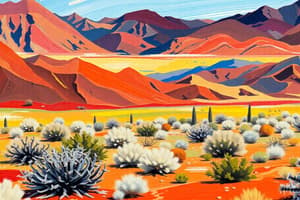Podcast
Questions and Answers
¿Dónde se encuentra el bioma de la tundra y cuáles son algunas de sus características distintivas?
¿Dónde se encuentra el bioma de la tundra y cuáles son algunas de sus características distintivas?
La tundra se encuentra en las partes más septentrionales del mundo y se caracteriza por sus temperaturas extremadamente frías, su suelo de permafrost y su corta temporada de crecimiento.
¿Qué define a los desiertos y cómo se adaptan las plantas en estos ecosistemas?
¿Qué define a los desiertos y cómo se adaptan las plantas en estos ecosistemas?
Los desiertos se caracterizan por su aridez, con precipitaciones mínimas y temperaturas extremas durante el día y la noche. Las plantas en los desiertos han evolucionado para conservar agua, como los cactus.
¿Dónde se encuentran los bosques tropicales y cuáles son algunas de sus características principales?
¿Dónde se encuentran los bosques tropicales y cuáles son algunas de sus características principales?
Los bosques tropicales se encuentran cerca del ecuador y se caracterizan por altas temperaturas, abundantes lluvias y vegetación densa.
¿Cómo se conocen también los pastizales y qué tipo de vegetación predominante presentan?
¿Cómo se conocen también los pastizales y qué tipo de vegetación predominante presentan?
¿Qué tipo de animales se pueden encontrar en la tundra y cómo han evolucionado para sobrevivir en este entorno?
¿Qué tipo de animales se pueden encontrar en la tundra y cómo han evolucionado para sobrevivir en este entorno?
¿Por qué los desiertos son considerados ecosistemas extremos y cómo han evolucionado las plantas para adaptarse a la escasez de agua?
¿Por qué los desiertos son considerados ecosistemas extremos y cómo han evolucionado las plantas para adaptarse a la escasez de agua?
Flashcards are hidden until you start studying
Study Notes
Introduction
Biomes are vast regions of land, water, and air where similar life forms thrive due to shared environmental characteristics. These regions are broadly categorized based on their dominant vegetation, temperature ranges, soil types, and sunlight availability. This article explores four diverse biomes: tundra, desert, rainforest, and grassland.
Tundra
The tundra biome is located in the northernmost parts of the world and is characterized by its extreme cold temperatures, permafrost soil, and short growing season. Despite the harsh climate, the tundra hosts a variety of specialized plant and animal species, such as mosses, lichens, and small mammals like Arctic foxes.
Desert
Deserts are found across both cold and warm climates globally. They are defined by their aridity, with minimal precipitation and extreme temperatures during the day and night. Despite these challenging conditions, desert ecosystems support unique plant species like succulents and camels, which have evolved to conserve water.
Rainforest
Tropical rainforests are located near the equator and are characterized by high temperatures, abundant rainfall, and dense vegetation. These biomes are home to many endemic species, including epiphytic plants, insects, amphibians, reptiles, birds, and mammals.
Grassland
Grasslands, also known as savannas, feature vast expanses of grasses and other low-lying vegetation. They are typically found in regions with a temperate climate and a dry season, making them highly dependent on regular rainfall. Grasslands are home to numerous species of grazers, such as bison, zebras, and various bird species.
Conclusion
In summary, biomes represent diverse ecological systems with unique characteristics that support specialized plant and animal communities adapted to their specific environmental conditions. The tundra, desert, rainforest, and grassland biomes each present distinct challenges and opportunities for life, contributing to the rich web of biodiversity found across our planet.
Studying That Suits You
Use AI to generate personalized quizzes and flashcards to suit your learning preferences.




